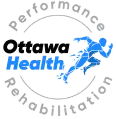Experience top-notch physiotherapy combined with compassionate care at Ottawa Health: Performance and Rehabilitation for the treatment of De Quervain’s tenosynovitis in Ottawa. Our team of skilled physiotherapists is dedicated to delivering tailored care that eases pain, restores function, and prevents reoccurrence of the condition.
Exploring De Quervain’s Tenosynovitis in Detail
De Quervain’s tenosynovitis is characterized by painful inflammation of the two tendons extending to the thumb and traveling along the wrist. A distinctive feature of this condition is the thickening of the tendon sheath, resulting in limited tendon movement, wrist pain, and swelling near the thumb’s base. This can lead to challenges in performing basic tasks involving gripping or pinching.
Root Causes and Contributing Factors:
- Repetitive Actions: Continuous hand or wrist movements can inflame or swell the tendon sheath.
- Direct Trauma: Sudden wrist trauma or injury can trigger inflammation.
- Health Conditions: Existing conditions like rheumatoid arthritis can heighten the risk.
- Pregnancy and Hormonal Shifts: These factors can lead to fluid retention and tissue changes, exacerbating the condition.
Signs and Symptoms to Monitor:
- Discomfort and Sensitivity: Pain on the wrist’s thumb side worsened by thumb movements or making a fist.
- Inflammation: Observable swelling over the wrist’s thumb side, sometimes accompanied by a fluid-filled cyst.
- Restricted Mobility: Challenges moving the thumb and wrist, especially when attempting to grasp or pinch.
- Feeling of “Catching”: Sensation of the thumb sticking or catching during movement.
Our Tailored Physiotherapy Approach to Treatment
At Ottawa Health: Performance and Rehabilitation, we lead the way in treating De Quervain’s tenosynovitis in Ottawa through physiotherapy, focusing on:
Customized Hand Therapy
- Enhancing Strength and Flexibility: Personalized exercises to boost wrist and thumb strength and flexibility, improving movement and reducing stiffness.
- Hands-On Therapy: Manual techniques to mobilize joints and soft tissues, alleviating pain and enhancing function.
Comprehensive Assistance
- Pain Relief: Gentle movements and other methods to effectively manage acute symptoms.
- Adjustments to Lifestyle: Suggestions to modify daily routines to aid recovery and prevent relapse.
- Ergonomic Recommendations: Guidance on adapting activities and work setups to reduce wrist strain, preventing further irritation or injury.
Wide Range of Treatment Options
At Ottawa Health: Performance and Rehabilitation, our dedication to your well-being goes beyond physiotherapy, offering a diverse range of services to meet all your rehabilitation requirements.
- Physiotherapy Treatments
- Chiropractors
- Custom-Made Orthotics
- Massage Therapy Services
- Cupping Therapy
- Shockwave Therapy Treatment
- Lumbar Spinal Stenosis Care
- Car Accident Physio
- GLA:D Physiotherapy
- Holistic Nutritionist Services
Reasons to Select Ottawa Health: Performance and Rehabilitation for De Quervain’s Tenosynovitis Treatment
When choosing Ottawa Health: Performance and Rehabilitation in Ottawa for your treatment, you are opting for:
- Hand Therapy Expertise: Our physiotherapists are skilled in addressing hand and wrist conditions using advanced, evidence-based methods.
- Customized Treatment Plans: Recognizing each case’s uniqueness, we offer tailored treatment plans focusing on your individual needs and recovery objectives.
- Comprehensive Care and Assistance: In addition to physiotherapy, we provide guidance on overall health to enhance your recovery and well-being.
Say Goodbye to Pain
If De Quervain’s tenosynovitis is affecting your daily activities, rely on Ottawa Health: Performance and Rehabilitation in Ottawa for expert care and assistance. Contact us today to explore our treatment options and start your journey towards regaining comfort and functionality in your hand. Your road to recovery begins here.
Wrist and Hand Conditions We Address
|
|
De Quervain’s Tenosynovitis Treatment Ottawa FAQs
Which Exercises Should I Avoid with De Quervain’s Tenosynovitis?
When managing De Quervain’s tenosynovitis, it is crucial to steer clear of activities and exercises that worsen the condition. Specifically, tasks involving repetitive thumb movements, forceful gripping, or wrist twisting can heighten irritation and inflammation in the affected tendons. Your physiotherapist will provide guidance on safe exercises and may suggest temporary restrictions on certain activities to facilitate tendon healing. Following a personalized exercise regimen and making necessary adjustments to daily activities are vital steps in the healing process.
Can De Quervain’s Tenosynovitis Resolve on Its Own Without Treatment?
While mild cases of De Quervain’s tenosynovitis may show some improvement with rest and activity modifications, untreated conditions may lead to worsening symptoms, reduced mobility, and persistent pain. Physiotherapy plays a pivotal role in treating and managing the condition by reducing inflammation, enhancing tendon function, and preventing recurrence. Techniques such as targeted exercises, manual therapy, and splinting are commonly recommended to alleviate symptoms and promote recovery.
Can De Quervain’s Tenosynovitis Return After Treatment?
Indeed, De Quervain’s tenosynovitis can recur post-treatment, especially if underlying factors like repetitive wrist and thumb movements are not adequately addressed. Continuous physiotherapy and adherence to ergonomic adjustments and exercise regimens are crucial in minimizing recurrence risks. Early recognition of condition signs and prompt treatment are vital in preventing symptom aggravation. A holistic approach encompassing physiotherapy, lifestyle modifications, and ergonomic interventions is essential in symptom management and recurrence prevention.
Is Prevention of De Quervain’s Tenosynovitis Possible?
While complete prevention of De Quervain’s tenosynovitis may not be feasible, adopting preventive measures can significantly reduce the risks, especially for individuals with predisposing factors. These measures include practicing good ergonomic habits to minimize wrist and thumb strain, engaging in exercises to strengthen the wrist and enhance flexibility, and avoiding repetitive motions that may irritate the tendons. Additionally, being mindful of wrist position during daily activities and seeking early intervention at the onset of wrist discomfort or pain can help prevent or mitigate the condition’s development.
Ottawa Health: Performance and Rehabilitation
1535 Bank St, Ottawa, ON K1H 7Z1, Canada
(613) 728-9414
Hours:
Monday to Thursday: 8 AM – 7:30 PM
Friday: 8 AM – 8 PM
Saturday: 10 AM – 2 PM
Sunday: Closed

